Matthew Kerns's Blog: The Dime Library, page 16
May 30, 2023
Dangerous Dance
From the Troy (New York) Times, July 23, 1868.
It is a question of whether audiences or performers most desire compassion in the heat. The latter have the least to wear, but they have to work very hard. The poor ballet girls, for instance—see how night after night they pirouette and perspire in a blaze of footlights, border lights, side lights, calcium lights, and red fire, where the heat they have to endure often sends them staggering and fainting to the wings. People in front know very little of the real tortures of the stage, for there are others far greater than the heat.

A few evenings since, for instance, Morlacchi, in one of her inimitable dances, stepped into the opening of an illy closed trap—her food was torn and wrenched severely, but she finished her dance. The next night she danced again, although her injuries were so great that for a week after, she could not walk.
Once, in Philadelphia, this same brave girl was turning rapid pirouettes, steadied by the hand of a male dancer. The audience applauded her enthusiastically. She was so beautiful and graceful. She smiled and, reversing her swift motion, continued the series of twirls for a brief space, then bounded light as a sylph from the stage while the house shook with the applause. None in the audience knew that during all that movement which charmed them so much, her tow had been resting in an auger hole in the stage and that her revolutions tore the nail entirely off…the most beautiful and finished danseuse often has her shoes filled with blood three times in the course of the evening when she is doing the “toe business” as walking and dancing on the point of the great toes is termed. It looks very pretty, and the public expects it, not knowing that the agony of its performance forces the blood from under the toes with an exquisite torture worthy of the Inquisition.
May 25, 2023
Blue Jean Birthday
This month we celebrate the 150th birthday of an iconic piece of clothing that has long been associated with the cowboy—blue jeans. Levi Strauss and his partner Jacob Davis patented the process of putting rivets at the stress points in men’s denim work pants on May 20, 1873.

The iconic blue jeans have a rich history that dates back to the 19th century. While the exact origin of denim is debated, it is believed to have started with fabrics like cotton duck and serge de Nimes, which were used in various applications such as sails, tents, and clothing. These sturdy fabrics were produced in places like Genoa, Italy, and Nimes, France.
In the 17th century, a Swiss banker named Jean-Gabriel Eynard played a role in the commercialization of a blue cloth called "bleu de Genes." This fabric was used to supply uniforms to troops under the command of André Masséna, one of Napoleon Bonaparte’s Marshals of the Empire. “Bleu de Genes” was soon anglicized as “blue jeans,” and the fabric was known for its durability and affordability.

The true birth of jeans as we know them today began in 1871 with a tailor named Jacob Davis. He was approached by a miner's wife who asked him to create pants that could withstand the harsh conditions of working in mines. Davis used durable "duck cloth" and reinforced the pants with copper rivets, creating the first pair of riveted trousers. Duck cloth, or duck canvas, was a heavier, plain woven cotton fabric canvas that was more tightly woven than plain canvas, originating from the Dutch word, doek, meaning "linen canvas."
Jacob Davis’ main cloth supplier was a San Francisco dry goods merchant named Levi Strauss. In 1872, Davis wrote to Strauss proposing a partnership to patent and sell their riveted clothing. The two men received a patent for their invention on May 20, 1873. They didn't call their pants "jeans," favoring "copper rivetted overall," but it wasn't long before the garment was known only as "jeans." The early jeans featured two front pockets, one back pocket, and copper rivets. They were initially made from brown cotton duck but later evolved to incorporate blue denim, a more flexible and widely available fabric.

When Texas Jack Omohundro established himself as America’s First Cowboy Star, blue jeans were not yet a standard part of the cowboy’s wardrobe. Jack preferred buckskin or leather trousers to stand up to the rigors of life on horseback. But soon, the affordability and durability of jeans made them popular among hard-working individuals in the American West, including factory workers, miners, farmers, and cattlemen. Cowboys, in particular, found jeans to be the perfect clothing for their demanding work. The ruggedness of jeans allowed cowboys to withstand long hours in the saddle and navigate tough terrain while protecting themselves from brambles and other hazards.
As jeans became mass-produced and more affordable, they gained popularity beyond the American West. They became a staple in the American wardrobe and were associated with cowboys through classical Western movies and TV shows. Because jeans came to be identified with the rugged individualism associated with the cowboy, they quickly caught on with anyone trying to depict a character as iconoclastic and bucking against authority. In the 1950s, movies like "Rebel Without a Cause" helped popularize jeans among the youth, and by the 1970s, wearing jeans as casual wear had become widely accepted throughout the United States. By the 1980s and 90s in Communist blok countries, blue jeans became a prized possession and a symbol of rejecting Communist party values in favor of the independence suggested by cowboy culture.

Today, blue jeans are not only known for their durability but also as a fashion statement. They are a versatile and timeless piece of clothing that can be found in everyday wardrobes, workwear, and even semi-formal attire. Blue jeans have remained an iconic symbol of American culture, representing ruggedness, comfort, and style. Just as there is no figure more iconically American than the cowboy, there is no pair of pants more iconically American than blue jeans.

May 22, 2023
Recolored Image of Texas Jack Junior
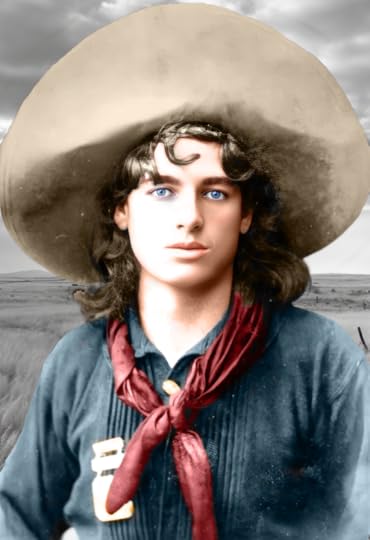
I've had quite a few requests for a recolorized image of Texas Jack Junior, so here you go!
This image was sharpened with Remini, and then retouched and adjusted for contrast in Photoshop. The coloring was also done in Photoshop, and then the portrait was superimposed on a MidJourney image of the American prairie.

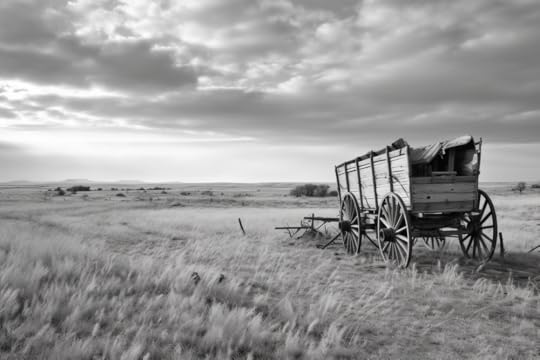
May 18, 2023
Restored Image of Texas Jack Junior
Recently, a new photo of Texas Jack Junior popped up online.

Sadly, the image is torn, and the tear covers Junior's face. Some of this damage can be corrected in Photoshop, but repairing the nose is the hardest part.

If we compare it to the other photos of Texas Jack Junior that we have, we can try to get as close to his nose as possible. In Photoshop, I took the nose from other pictures of Junior and superimposed, rescaled, and moved it until I matched it up the best I could.
[image error][image error]Finally, I ran the resulting image through Remini to sharpen it up a little bit. The result is probably as close as we can come to having a glimpse of Texas Jack Junior at this moment in his career. I love the Lone Star emblems on his hat.
Like his namesake, Texas Jack Omohundro, Junior used the Lone Star as a symbol of being a Texas cowboy, one of the reasons it made sense for the NFL Dallas Cowboys to use the same icon to illustrate their ties to their state's most famous profession.

May 15, 2023
80 John Wallace
Daniel Webster "80 John" Wallace was born in Victoria County, Texas in 1860 to parents who were both slaves. Daniel’s mother, Mary Barber, was sold to the O’Daniel family just three months before 80 John’s birthday on September 15, 1860. Raised on the O'Daniel plantation, he grew up alongside the O'Daniel family and maintained a close relationship with Mr. O’Daniel’s sons, M.H. and Dial, throughout his life. As a young boy, he listened to the stories of the ranch’s working cowboys. He yearned to become a cowboy and longed to ride horses and work with cattle. At the age of 15, he ran away and joined a cattle drive as a spare hand and horse wrangler, quickly proving his skills and earning a reputation as a reliable and skilled cowboy.

During the late 1800s, Wallace rode the range and worked for some of the most renowned cattle barons of the time, including C.C. Slaughter and Andrew B. Robertson. He gained experience and respect as a cowboy, riding major cattle trails and facing numerous challenges such as stampedes, river crossings, Comanche raids, and snowstorms. Known for his impeccable work ethic, integrity, and business acumen, 80 John built lasting friendships among his fellow cowboys.
In 1885, Wallace started working for the prominent cattleman Clay Mann, who recognized his intelligence and potential. The pair developed a plan in which Wallace would save part of his wages to invest in his own herd, with Mann providing free pasture. This arrangement nurtured a strong bond of trust and respect between the two men. In 1885 Wallace purchased his first land and began his journey toward becoming a successful rancher. At 25 years old, 80 John went back to school, and education became a core part of his system of values. Clay Mann’s cattle brand was an 80, and he was known as “80 Clay” Mann. Wallace used the same brand, and soon he was known to cowboys and cattlemen across the West as “80 John.”

With his wife Laura by his side, Wallace gradually built his herd and established himself as a respected rancher. The couple endured hardships and implemented progressive ranching practices, including the installation of the area's first windmill. Wallace emphasized the value of education, using the money he earned from ranching to ensure that his children and grandchildren were each given the opportunity to go to college. John and his wife also invested their wealth into supporting local schools and churches while engaging in philanthropic endeavors, allowing 80 John the chance to share his wisdom and resources with the community. 3 of 80 John's 4 children became teachers, and a local school was named after him in honor of his legacy.

By the time of his passing on March 28, 1939, Wallace had accumulated a net worth of over one million dollars, a remarkable achievement considering the limited opportunities available to formerly enslaved individuals and their descendants. He left a lasting legacy of integrity, progressive ranching methods, and a commitment to education. His descendants still operate the family ranch and live on 80 John’s land, with the original homestead house donated and moved to the Texas Tech National Ranching Heritage Center as a tribute to Wallace's vision and accomplishments.
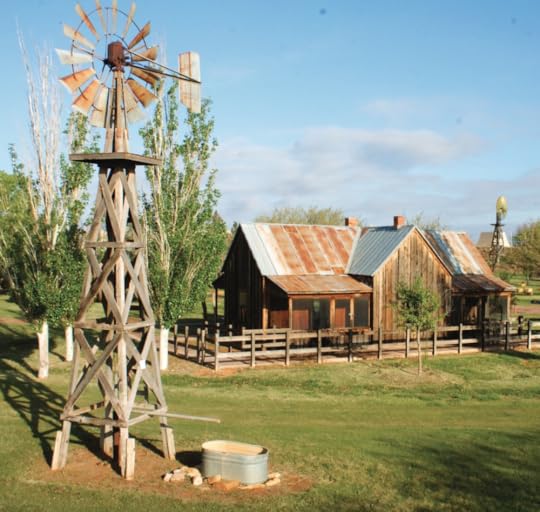
On April 15, 2023, 80 John Wallace was inducted into the National Cowboy & Western Heritage Museum’s Hall of Great Westerners. Daniel Webster "80 John" Wallace's story is a testament to his leadership, determination, and resilience in a time marked by racial and social divisions. Despite facing challenges and discrimination, 80 John formed deep bonds of friendship with fellow cowboys, both black and white, transcending societal barriers. He was a prominent member of the Texas Cattle Raisers Association and played an active role in their meetings. Wallace's legacy extends beyond his personal success, as he exemplified the spirit of the American cowboy and the contributions of black cowboys to the ranching and cattle industry.

May 13, 2023
Morlacchi Has Left the Party
"Morlacchi has left the Buffalo Bill party, and is now dancing in "Humpty Dumpty," at the Olympic, New York. The Herald says she is the only truly great danseuse who has appeared since the days of Fanny Ellsler."
-Chicago Tribune, May 4, 1873.

At the end of April 1873, after four and a half months of touring as Dove Eye in The Scouts of the Prairie with Buffalo Bill Cody, Texas Jack Omohundro, and Ned Buntline, the Peerless Giuseppina Morlacchi left the show for a headling engagement on Broadway. Reviews were glowing.
"The evolutions of Morlacchi, in her exquisitely soft, poetic, and classic Terpsichorean displays," wrote the critic for the New York Herald, "beyond question illustrate the "poetry of motion" as nearly as the "human form divine" is capable. The danseuse is dreamy, delicious, and sylph-like in every pose and sault."
The woman who replaced Morlacchi in the show was Bessie Sudlow, a Liverpool-born burlesque performer. Sudlow received none of the praise heaped upon Morlacchi, and ticket sales suffered.

Ned Buntline and Buffalo Bill must have missed Morlacchi's contributions to the show and to their fortunes, but no one missed the peerless ballerina more than the cowboy Texas Jack. Four months after she left the Scouts of the Prairie, Morlacchi was performing in Rochester, New York. Jack showed up at the theater, asked her to marry him, and they were married that weekend. They remained together until his death.
May 12, 2023
Pre-order Red Sapphire by Julia Bricklin
There are very few writers whose books are automatic purchases for me. When Bill Bryson announces a new book, I go ahead and click "Add to Cart." When Jon Meacham has a new one coming, I add it to my list. And when Julia Bricklin publishes a brand new book, I know I'm going to discover a riveting tale of forgotten history that takes me back in time, where I'm guaranteed to find something astounding in the unknown.

Julia's new book is an exciting dive into a dark era in American history that will transport you to the captivating world of Hollywood's infamous Blacklist. Cracking these pages, you'll uncover the extraordinary story of Hannah Weinstein and her revolutionary company, Sapphire Films. Using declassified FBI and CIA files, interviews, and the personal papers of blacklisted writers and other sources, Red Sapphire depicts how for the better part of a decade, Weinstein was a leader in the Left’s battle with the Right to shape popular culture during the Cold War . . . a battle that she eventually won.
If I haven't suggested Julia Bricklin's books to you before, then here's the scoop: Bricklin is known for her masterful storytelling, deep understanding of the complexities of American history, and careful consideration of marginalized people and forgotten history. Two of my favorites by her are "The Notorious Life of Ned Buntline: A Tale of Murder, Betrayal, and the Creation of Buffalo Bill" (my review is here) and "America's Best Female Sharpshooter: The Rise and Fall of Lillian Frances Smith." Meticulously researched and compassionately told, her stories are so much fun to read, and I am very much looking forward to this one, which I preordered the day it popped up on Amazon.
"Red Sapphire" shines a spotlight on Hannah Weinstein, a trailblazing woman who was way ahead of her time, and her indomitable spirit that defied the constraints of the Hollywood Blacklist era. Bricklin explores Weinstein's untold contributions to the film industry, unearthing a story of resilience, creativity, and triumph over adversity. In this engrossing narrative, Weinstein's company, Sapphire Films, emerges as a beacon of artistic integrity amidst a time of intense scrutiny and censorship. Julia's prose is vivid and her tone absolutely captures an essential truth about the realities of this tumultuous period.
Writers need preorders. It's how publishers decide how much of their marketing weight they're going to use to support books and their authors. So here's my pitch:
In the pages of "Red Sapphire: The Woman Who Beat the Blacklist," Julia Bricklin invites us into a forgotten chapter of history, where one woman's resilience and determination shattered political and social barriers. This book is a monument to and a celebration of the courage of Hannah Weinstein and her enduring legacy. And it's a hell of a good story.
May 9, 2023
Buffalo Bill & The Indians
When people think of Buffalo Bill Cody, they often get caught up on two historical fallacies. The first is that Bill Cody was a horrific slaughterer of the American bison, otherwise known as the buffalo. The second is that his participation in the near-extermination event of the buffalo was driven by genocidal urges and federal dollars to deny Native American tribes their primary food source in hopes of eliminating them entirely.

I see this interpretation of Cody's buffalo hunting days a lot, but I don't believe it is entirely accurate. William F. Cody hunted bison to feed the westward expansion of the railroad, but only for about 18 months. By the end of 1869, he worked full-time as a scout for the Army at Fort McPherson. During those 18 months, he earned a reputation as a great buffalo hunter, but he didn’t stand on a distant hill with a high-powered rifle and a looking glass, picking off docile creatures with no danger to himself. Bill Cody hunted the same way the Sioux, Cheyenne, and Pawnee did. He rode his horse towards a herd, separated the animal he would harvest, and ran alongside it until he could get the best shot possible. Cody killed a few animals at a time and brought them back to be used to feed the men working on expanding the railroad west. Despite what many think, he was never a hide hunter and never slaughtered buffalo indiscriminately for either the choice cuts (tongue and loin) or their hides.
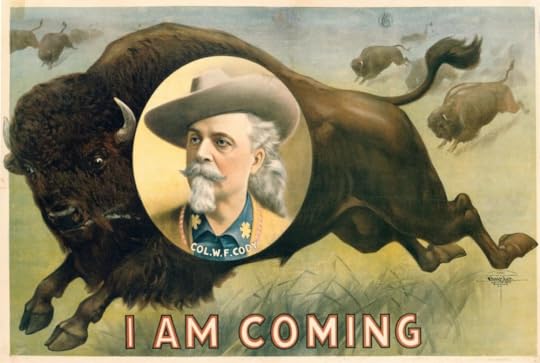
By 1873, when desperate economic times made hide hunting more attractive, Buffalo Bill and Texas Jack had left the prairies of Nebraska and the herds of buffalo that roamed it behind to become successful (and quite wealthy) actors. They would occasionally return west to hunt but were never again a significant factor in the decline of the bison.
As part of his job as a scout, Buffalo Bill was involved with several altercations with Miniconjou, Lakota, Brule, Cheyenne, etc. Still, he never set out to murder Native Americans or to eliminate the bison, the staple of their diet, directly.
That said, Bill Cody did kill multiple Native American men in conflict, and those incidents, especially his combat with and killing of Yellow Hair, were inflated and magnified in dime novels and on stage. He became a legendary "Indian fighter" more because of the legend than the reality. Cody, like the Native people he fought against, knew that when they went to war someone was going to kill and someone was going to be killed. Each man fought desperately to ensure that he was the former, and though they were enemies, each man held a measure of respect for his adversary.
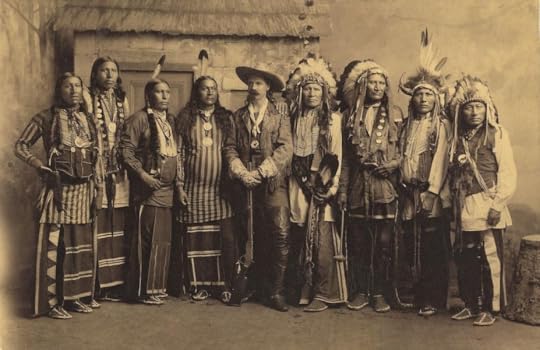
Likewise, Texas Jack was involved in conflicts with Sioux, Cheyenne, and Comanche warriors and developed a reputation as an "Indian fighter" despite having warm relations with the Pawnee tribe, joining them on their summer buffalo hunt in 1872, writing warmly about them in national publications, and being requested personally to join them by Pawnee head chief Pitaresaru (Chief of Men). Texas Jack also involved Cayuse native Donald McKay and his wife and daughter in his show well before Buffalo Bill ever brought Sioux into his Wild West shows.
Whatever failing Cody exhibited in his younger life in regard to Native Americans must be contrasted with his later life. His inclusion of Lakota in his Wild West show, including Sitting Bull himself, allowed them to travel, but more importantly to maintain and display their ceremonial dances and customs at a time when they were prevented by the United States government and Army from holding their religious ceremonies on the reservations. Cody paid the Native men and women in his show the same as he did the white cowboys, treated them fairly, kept families together, and was regarded as a warm friend by a great many of the Lakota that traveled with him.

Over time, Buffalo Bill Cody became a stalwart advocate for Native peoples and their rights. In the same way, Cody’s inclusion of the bison in his Wild West shows made sure that spectators at the shows were endeared to the animals. Over time, they became a symbol of not just the Wild West, but of America writ large. Because the hundreds of thousands of people who saw the bison in Buffalo Bill’s Wild West now cared about the animals, they supported conservation movements that brought them back from the brink of extinction. The man who earned his name as a buffalo hunter became one of the primary forces in their survival.
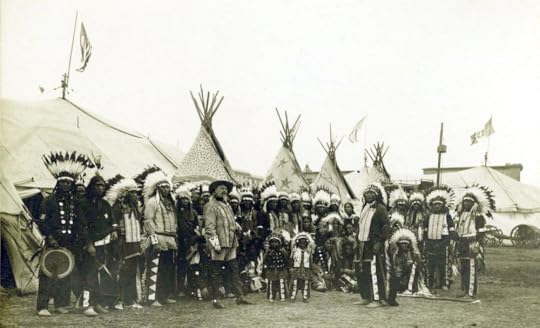
Cody publicly blamed most of the trouble between white men and Native tribes on the white men. He said that:
"In nine cases out of ten where there is trouble between white men and Indians, it will be found that the white man is responsible Indians expect a man to keep his word. They can't understand how a man can lie."
Dr. George Kingsley, who hunted with Cody and Omohundro, wrote that “[Buffalo Bill and Texas Jack] have a sympathy and a tenderness toward the Indians infinitely greater than you will find among the greedy, pushing settlers, who regard them as mere vermin who must be destroyed for the sake of the ground on which depends their very existence. But these men know the Indian and his almost incredible wrongs, and the causes which have turned him into the ruthless savage that he is, and often have I heard men of their class say that, before God, the Indian was in the right, and was only doing what any American citizen would do in his place.”
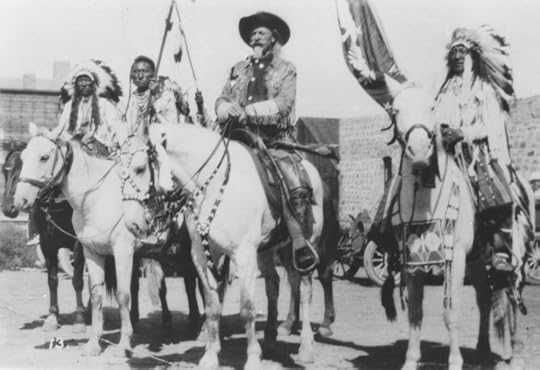
I'm not saying Buffalo Bill Cody and Texas Jack Omohundro were saints, just that they were complex people, both a product of their times and the prevailing attitudes of it, but capable of rising to the challenge of treating people humanely in the face of those attitudes.
I'll leave the last words to those native men who knew Buffalo Bill and called him "Pahaska," or "long hair," and considered him a friend. Black Elk (Heȟáka Sápa) spoke of Cody's "strong heart," and reportedly was touched by his spirit of generosity. Sitting Bull (Tȟatȟáŋka Íyotake) treasured a hat that Cody had given him, and reportedly grew quite angry when a relative once wore it. "My friend Long Hair gave me this hat," the great Hunkpapa chief boasted," I value it highly, for the hand that placed it upon my head had a friendly feeling for me." And Chief Red Fox (Tokála Luta) offered this great praise to his friend after his death: "In my imagination, I can see his noble spirit winging over the lofty peak, and I bow my head in memory of one who always impressed me with kindness and compassion, and enriched me with the deeply entrenched integrity of his character."
May 1, 2023
Bass Reeves
Bass Reeves was a legendary lawman who became one of the most accomplished, admired, and respected figures in the American West during the late 19th and early 20th centuries. Born into slavery in 1838 in Arkansas, Bass was named after his grandfather Bass Washington and was owned by William S. Reeves, who eventually moved to Texas, taking his then-8-year-old slave with him. William’s son George Robertson Reeves may have taken possession of Bass at some point. George R. Reeves would go on to serve as Texas’s Speaker of the House and as a Colonel in the Confederacy’s 11th Texas Cavalry Regiment. In 1861, Bass escaped from slave owner Reeves and headed to Indian Territory, where he lived among the Creek and Seminole tribes until the end of the Civil War. One account says that Bass and George Reeves fought over a game of cards, with Bass beating George badly in the ensuing fistfight. After the war, Bass and every other former and current slave was freed by the 13th Amendment, and he settled in Arkansas and farmed with his family.

In 1875, Reeves was appointed as a deputy U.S. Marshal for the Western District of Arkansas, making him the first Black deputy to serve west of the Mississippi River. He served under the “Hanging Judge,” Isaac Parker, as one of the 200 deputy U.S. marshals hired by James A. Fagan. Reeves was intimately acquainted with Indian Territory from his time there after his escape, and his knowledge of the land and terrain, the relationships with Cherokee and Creek people in the area, and his ability to speak their languages made him one of the most effective lawmen in Indian Territory. Reeves was known for his exceptional tracking skills and his ability to outsmart and apprehend some of the most notorious outlaws of the day. He was also known for his marksmanship and ability to maintain his cool in the most dangerous situations. It's said that Bass Reeves never once had to kill a man in the line of duty.

Reeves was instrumental in bringing law and order to the Indian Territory, where he worked for more than 30 years. He became a master of disguises and often used his ability to blend in with the local population to track down and apprehend fugitives. Reeves was also a respected member of the community, and it is said that he was often called upon to settle disputes and serve as a mediator between different groups.
One of the most remarkable stories from Bass Reeves’ long and distinguished career involves his own son. In the late 1890s, Bass was serving as a deputy U.S. Marshal in the Indian Territory (present-day Oklahoma). He received a warrant for the arrest of a man named Bennie, wanted for the murder of his wife. Bennie Reeves was Bass Reeves' own son, who had fled the territory and was hiding out in Texas.

Despite the personal connection, Bass Reeves took his duty as a lawman seriously and set out to track down and apprehend his own son. He traveled to Texas and spent several days gathering information and tracking Bennie Reeves' movements. Eventually, he was able to locate his son and make the arrest.
According to some accounts, Bass was forced to shoot Bennie during the arrest, as his son had allegedly resisted and attempted to draw a weapon. However, other reports suggest that the arrest was made without violence and that Bass Reeves was able to bring his son in peacefully. Bennie was subsequently captured, tried, and convicted. He served 11 years at Fort Leavenworth in Kansas before his sentence was commuted and he reportedly lived the rest of his life as a model citizen
Regardless of the details, the arrest of Bennie Reeves by his own father was a dramatic and emotional event, and it speaks to the strength of Bass Reeves' commitment to justice and the rule of law. It also underscores the difficult and often dangerous nature of law enforcement in the American West, where family ties and personal relationships could be complicated by the demands of duty and the need to maintain order in a rugged and untamed land.
Despite his many accomplishments, Reeves faced discrimination and racism throughout his career. He was often paid less than his white counterparts and was not allowed to participate in arrests or trials that involved white suspects. However, Reeves remained steadfast in his commitment to justice, and his reputation as a fair and effective lawman eventually earned him the respect of even his harshest critics.

Reeves retired from his position as a deputy U.S. Marshal in 1907 at the age of 68. He lived out the rest of his life in Muskogee, Oklahoma, where he served two years on the Muskogee police force. Bass died there in 1910. Today, Reeves is remembered as one of the most iconic figures of the American West, and his legacy as a trailblazing lawman continues to inspire generations of people who seek to uphold the principles of justice and equality. In 2010, the U.S. Marshals Service honored Reeves by dedicating a statue in his likeness at the federal courthouse in Fort Smith, Arkansas, where he once worked.
Bass Reeves is rightfully remembered as one of the most effective and impressive lawmen in American history, and Yellowstone creator and showrunner Taylor Sheridan is currently working on a new television series tentatively titled “Lawmen: Bass Reeves,” and starring British actor David Oyelowo as Bass Reeves, Dennis Quaid as Deputy U.S. Marshal Sherrill Lynn, and Donald Sutherland as Judge Isaac Parker.
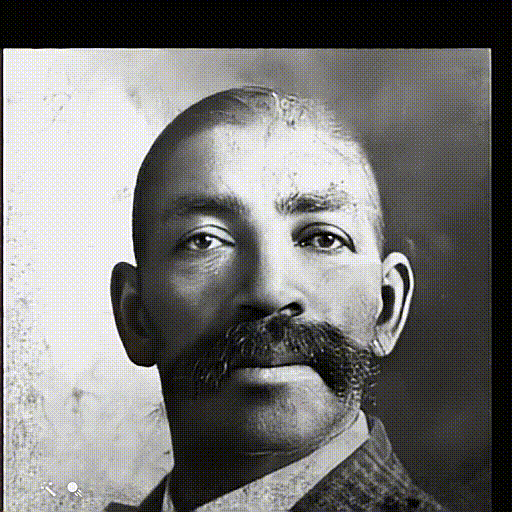
April 23, 2023
Press Release - Chattanooga Author Matthew Kerns Accepts Literary Prize at Star-Studded Awards Cerem
Chattanooga Author Matthew Kerns Accepts Literary Prize at Star-Studded Awards Ceremony

Oklahoma City, OK - Matthew Kerns, a Chattanooga area historian and author, has been honored with the Western Heritage Award for Outstanding Magazine Article for his article, "Texas Jack Takes an Encore," in Wild West Magazine. The prestigious literary prize was presented at the National Cowboy & Western Heritage Museum in Oklahoma City on April 15, where Kerns was surrounded by a host of celebrities from the entertainment industry.
The awards ceremony was a star-studded event, with many notable personalities from the world of film, music, and literature in attendance. Some of the other honorees included renowned actor Lou Diamond Phillips, musicians Red Steagall and Michael Martin Murphey, director Walter Hill, and beer magnate Pete Coors. The event was emceed by Lakota actor Mo Brings Plenty, who kept the audience entertained throughout the night.
Presenters for the awards ceremony included John Wayne's son Patrick Wayne and his daughter Anita La Cava Swift, Grainger Hines, Bobby Carradine, Longmire author Craig Johnson, and musicians Kix Brooks and Ronnie Dunn. The event was a celebration of Western heritage and culture, honoring those who have made significant contributions to the genre.
Matthew Kerns was thrilled to be recognized with such a prestigious award, and he expressed his gratitude to the organizers and his fellow honorees. "I appreciate very much the opportunity to tell Texas Jack's story, and the great honor that this award represents." he said. "It's humbling to be included in such a talented group of individuals, and I hope that my work continues to inspire others to explore the rich history and culture of the American West."
The Western Heritage Awards are presented annually by the National Cowboy & Western Heritage Museum, and they recognize outstanding contributions to Western literature, film, and music. The awards are a celebration of the people and stories that have shaped the American West, and they are highly respected within the industry.
For more information about Matthew Kerns and his work, please visit his website at www.dimelibrary.com.




